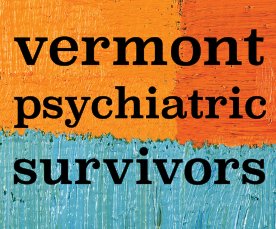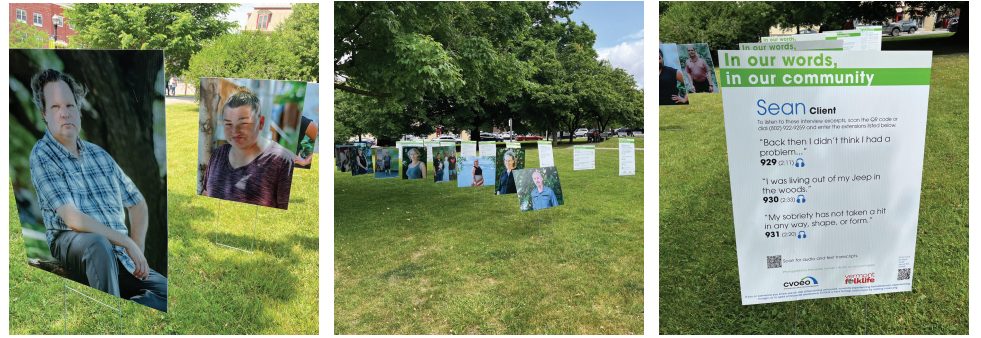Vermont Folklife’s research for In our voices, in our communities, a timely traveling exhibition of portraiture and storytelling with a focus on homelessness, began more than two years ago. When it finally debuted in Burlington this spring, one day after the passage of the state’s annual budget, the legislature’s controversial decision to end Vermont’s pandemic-era emergency housing program had drawn the issue into local headlines as never before.
2023 also brought the statistical revelation that Vermont now ranks second in the nation, after California, in per-capita homelessness. Its official count first skyrocketed following the state’s effort in 2020 to avoid the spread of COVID-19 in congregate shelters by opening the doors to motels across Vermont to all comers, with the feds footing the bill.
But amid a housing shortage that feels more dire by the day, our state reportedly may soon claim the top spot. As advocates push for solutions, In our voices, in our communities offers a glimpse into the lived experiences that underlie what appears to have become Vermont’s most pressing political debate.
Vermont Folklife, a nonprofit staffed by educators and anthropologists, teamed with the Burlington-based photographer Macaulay Lerman and the Champlain Valley Office of Economic Opportunity to produce the project. It takes the form of a one-day public art installation, with rows of lawn-sign wickets creating a portrait gallery of currently or recently homeless Vermonters and of the CVOEO employees who work with them.
On June 10, the exhibition occupied the northwest corner of the St. Albans town green, Taylor Park, from 11 a.m. to 4 p.m., overlapping with the city’s adjacent farmers market. A CVOEO representative was on hand to answer questions.
The back of each photograph displayed quotations from an interview with the subject, along with an individualized QR code linking to lengthy audio clips on the CVOEO website. Bringing earbuds helped.
Insofar as these recordings comprise the meat of the project, the physical installation – which subsequently appeared in Middlebury and Swanton over the summer, with more showings to come – functions more as an advertisement for the online exhibition than it does as a stand-alone show. In St. Albans, several passersby stopped to take note.
CVOEO bills In our voices as a work of “collaborative ethnography, a method that engages the individuals whose lives are being documented in both shaping the research process and in determining how their experiences are shared with the public.”
The curators present the narratives of homelessness recorded for In our voices as monologues, but their patterns of autobiographical explication often suggest a set of off-microphone questions structuring the speakers’ reflections. At one point, a social worker named Jess stresses the organic eagerness with which her clients tend to publicize the causes of their circumstances when they ask for help, hinting that the interviewers may not have needed to do much coaxing.
“People really want to give an explanation and a story behind what their request is,” she observes. “I have seven other phone calls to make, but they all take double to ten times longer than just the provision of service, because people want to tell us the story.”
Naturally or otherwise, the accounts here take shape primarily as explanations, tending to invoke addictions or psychiatric labels. But they also draw attention to the randomness of life and its consequences in a system with few state guardrails or social supports, where a workplace accident or a falling-out between family members can change everything.
Some narratives find room for surprising digressions. One man, after mentioning his bipolar diagnosis, recounts his family history, which includes victims of the sinking of the Titanic and the architect of the historic Bronx River Highway.
Another narrates how he spent the last dollars in his checking account to buy a Greyhound ticket for his terminally ill brother in Phoenix, who wanted to die beside him on the streets of Burlington, their hometown. Ultimately, a surgeon at UVM Medical Center saved the brother’s life instead.
We also hear descriptions of the day-by-day content of homelessness. By one account, it is a matter of “only walking or trying to sleep and staying out of the cold and out of the heat. But only that. Walking, carrying things, being, having no shelter. It’s always walking.”
Six of the interviews offer first-person chronicles of this reality; the nine musings by service providers outnumber them. To the extent that the latter constitute secondhand glimpses of the phenomenon in question, the discrepancy undercuts the premise and even the title of the exhibition. But these clips allow the exhibition to address homelessness not just as an experience but as an economic and political problem.
One CVOEO worker points out that, over the course of her 25-year tenure at the agency, the welfare payments that she has dispensed – as part of the Reach Up program for low-income parents, for instance – have not increased, despite significant inflation. Another notes that Vermont’s extreme housing shortage has rendered tenant voucher programs ineffectual.
“I listed off all of these resources that we have to be able to pay for them to have security deposits and rental assistance. And those programs, we’re not even spending them down. There’s sort of money sitting there, and it’s sitting there because we don’t have homes for people to move into. We have ample funding and resources to be able to get them into them – they just don’t exist,” she says.
Several CVOEO clients still attest to the usefulness of the agency’s offerings. And when a staffer, foreshadowing summer 2023’s sense of crisis, discusses the 2021 closure of the Holiday Inn in South Burlington and the fight to ensure that its residents would receive new placements at other hotels, she foregrounds not only the loss of housing but the loss of access to services.
“We had folks working 24/7 there. And so it was a lot of mental health support, which is the primary thing affecting folks that are homeless,” says Taylor.
But another employee acknowledges the limits of the agency’s abilities, and even of its underlying ideological apparatus.
“The strategy that we have for ending poverty is, we’ll take each of you individuals who have been unfortunate enough to find yourself in it and we’ll fix you. You’re what needs fixing,” Jess says. “I struggle with it because it often feels like, if you’re putting Band-Aids on something and sort of fixing it at that each individual level, you’re allowing it to perpetuate and continue because it’s not getting to the real triage point of forcing that larger change.”
This approach isn’t the only way, even at the level of direct assistance. In our voices also highlights the systems of mutual aid among Vermont’s homeless population.
‘It’s like people who don’t have anything taking care of other people who don’t have anything. It’s so beautiful. It’s sad that it has to happen, but it’s lovely,” says Toni from CVOEO.
Sean, who cites his struggles with alcoholism, depression, anxiety, and PTSD, is one example. Now he plans to become a peer recovery coach.
“I was in a dark place, where I thought maybe I might be better off not here anymore,” he says. “It weighs heavy on my heart seeing other people like that.”
The final days for In our voices, in our communities are Sept. 15 and Oct. 13 at the Alburgh Public Library and Burlington’s Champlain Street Park, starting at 1 p.m. and 11 a.m., respectively.

